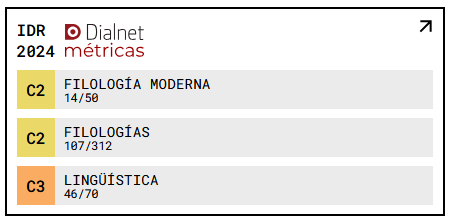Morrison’s Blue-Eyed Golem
A Reenactment of the Third Man Argument
DOI:
https://doi.org/10.18172/jes.5901Keywords:
Toni Morrisson, Philosophy, The Bluest Eye, Third Man Argument, Golem, BorgesAbstract
This article deals with Toni Morrison’s first novel, The Bluest Eye, as a possible interweaving of Aristotle’s Third Man Argument into both societal and psychological aspects of the contemporary world. Rooted in this philosophical background, it follows the decline of Pecola Breedlove’s mental stability throughout three segments that mimic the argument’s structure. The degradation of archetypes and the character’s conception of beauty articulate our thesis as it attempts to present the novel as a reenactment of the philosophical theory resorting to Borges’ poem “El golem” to strengthen the connection between Morrison’s take on Afro-American realities and Aristotle’s position regarding the degradation of the ideal.
Downloads
References
Alighieri, Dante. The Divine Comedy. Translated by C. H. Sisson, Oxford World’s Classics, 2008.
Al Kayed, Murad, and Majd Al Kayid. “Toni Morrison’s The Bluest Eye As a Prose Version of T.S. Eliot’s The Waste Land.” Research on Humanities and Social Sciences, vol. 5, no.12, 2015, pp. 109-111.
Borges, Jorge Luis. “El golem”. Obras Completas II. Emecé Editores, 1996 (1958), pp. 263-265.
Botero Camacho, Manuel. El Abismo Lógico: Borges y los filósofos de las ideas. Universidad del Rosario, 2009.
Cardona, Nancy K. “They Treated Me Like A Geography Lesson: “Beauty Culture and ethnicity in Toni Morrison’s ‘The Bluest Eye’ and Julia Alvarez’s ‘How the Garcia Girls Lost Their Accents’.” Voces: A Journal of Chicana/Latina Studies, vol. 1, no. 1, 1997, pp- 12-27.
Dittmar, Linda. “Will the Circle Be Unbroken? The Politics of Form in ‘The Bluest Eye’.” NOVEL: A Forum on Fiction, vol. 23, no. 2, 1990, pp. 137-155. DOI: https://doi.org/10.2307/1345735
Du Bois, William. E. B. The Souls of Black Folk. Oxford World’s Classics, 2007 (1903).
Di Giovanni, Norman Thomas, editor. “The Golem”. Selected poems 1923-1967 [of] Jorge Luis Borges. Translated by John Hollander. Allen Lane, 1972, pp. 111-115.
Fick, Thomas H. “Toni Morrison’s ‘Allegory of the Cave’: Movies, Consumption, and Platonic Realism in ‘The Bluest Eye’.” The Journal of the Midwest Modern Language Association, vol. 22, no. 1, 1989, pp. 10-22. DOI: https://doi.org/10.2307/1315270
Hofstadter, Douglas. R. Gödel, Escher, Bach: An Eternal Golden Braid. Basic Books, 1999 (1979).
hooks, bell (sic). Yearning Race, Gender, and Cultural Politics. South End Press, 1999 (1990).
Klotman, Phyllis. R. “Dick-and-Jane and the Shirley Temple Sensibility in the Bluest Eye.” Black American Literature Forum, vol. 13, no. 4, 1979, pp. 123-125. DOI: https://doi.org/10.2307/3041475
Kuenz, Jane. “The Bluest Eye: Notes on History, Community, and Black Female Subjectivity.” African American Review, vol. 27, no. 3, 1993, pp. 421-431. DOI: https://doi.org/10.2307/3041932
Morrison, Toni. Playing in the Dark: Whiteness and the Literary Imagination. Harvard University Press, 1992.
Morrison, Toni. The Bluest Eye. Vintage, 2019 (1970).
Morrison, Toni. Paradise. Vintage, 2022 (1997).
Plato. Plato: Complete Works. Hackett Publishing, 1997.
Roye, Susmita. “Toni Morrison’s disrupted girls and their disturbed girlhoods: ‘The Bluest Eye’ and ‘A Mercy’.” Callaloo, vol. 35, no. 1, 2012, pp. 212-227. DOI: https://doi.org/10.1353/cal.2012.0013
Russell, Bertrand. History of Western Philosophy. Routledge Classics, 2004 (1945). DOI: https://doi.org/10.4324/9780203487976
Schur, Richard L. “Locating Paradise in the Post-Civil Rights Era: Toni Morrison and Critical Race Theory.” Contemporary Literature, vol. 45, no. 2, 2004, pp. 276-299. DOI: https://doi.org/10.1353/cli.2004.0019
Surányi, Ágnes. Tally, Justine, editor. “The Bluest Eye and Sula: black female experience from childhood to womanhood”. The Cambridge Companion to Toni Morrison, edited by Justine Tally, Cambridge University Press, 2007, pp. 11-25. DOI: https://doi.org/10.1017/CCOL052186111X.002
Vásquez, Sam. “In Her Own Image: Literary and Visual Representations of Girlhood in Toni Morrison’s The Bluest Eye and Jamaica Kincaid’s Annie John.” Meridians, vol. 12, no. 1, 2014, pp. 58-87. DOI: https://doi.org/10.2979/meridians.12.1.58
Wardi, Anissa Janine. “A Laying on of Hands: Toni Morrison and the Materiality of ‘Love’.” MELUS, vol. 30, no. 3, 2005, pp. 201-218. DOI: https://doi.org/10.1093/melus/30.3.201
Zamalin, Alex. “Beloved Citizens: Toni Morrison’s ‘Beloved’, Racial Inequality, and American Public Policy.” Women’s Studies Quarterly, vol. 42, no. ½, 2014, pp. 205-211. DOI: https://doi.org/10.1353/wsq.2014.0004
Downloads
Published
How to Cite
Issue
Section
License
Copyright (c) 2024 Manuel Botero Camacho, Judit Climent Torras

This work is licensed under a Creative Commons Attribution 4.0 International License.
The authors retain copyright of articles and authorize Journal of English Studies the first publication. They are free to share, redistribute, and/or reprint the article without obtaining permission from the publisher as long as they give appropriate credit to the editor and the journal.
Self-archiving is allowed too. In fact, it is recommendable to deposit a PDF version of the paper in academic and/or institutional repositories.
It is recommended to include the DOI number.
This journal is licensed under a Creative Commons Attribution 4.0 International License













